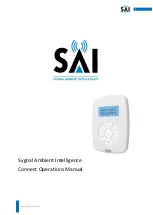
1-2
Fire suppression systems control fire using agents such as dry chemical, CO
2
, and INERGEN
,
etc. Each of these systems must be specifically designed and approved for use on a particular fire
hazard.
When the AutoPulse Z-10 is programmed as an agent release system, it controls releasing devices
(also known as solenoids, actuators, etc.) that are connected to a set of storage tanks containing the
agent. When alarm activation is detected, the AutoPulse Z-10 activates the releasing devices and
discharges the extinguishing agent.
Programming the AutoPulse Z-10 for agent release involves selecting one of the pre-programmed
agent release applications pre-installed on the AutoPulse Z-10. Single hazard (single area) and
dual hazard (two separate areas) programs are available, all of which support manual release, abort
switches, and programmable delay timers. See the next section of this chapter for a complete
description of each application.
The most common type of preaction sprinkler system is the
single interlock preaction system
,
which uses a two-phase process for actuating sprinkler heads.
Phase 1.
Alarm activation of an initiating device attached to the AutoPulse Z-10 causes the
AutoPulse Z-10 to activate the releasing device attached to the sprinkler system’s Primary
Control Valve. When this valve is open, water flows into the sprinkler pipes, readying the
sprinkler system for the possible activation of one or more sprinkler heads. This is known as
“preaction.”
Phase 2.
Sprinkler head(s) open in response to a fire condition, releasing water onto the fire
area.
Special situations sometimes require the use of a
double interlock preaction system
, in which an
automatic initiating device (smoke or heat detector) and a sprinkler head must operate
simultaneously
to initiate water flow. This differs from the single interlock system, where these
two actions (initiating device and sprinkler head activation) can occur at different times.
A
deluge system
uses open sprinklers. Activation of initiating devices releases a deluge valve,
producing immediate water flow through all sprinklers. Deluge applications are typically found in
special situations, where high-flow, water-based suppression is required.
In some areas of the country, Authorities Having Jurisdiction (AHJs) have started requiring
building owners to protect critical electronic areas, normally covered only by Agent Release
systems, with a combination of Agent Release (primary) and Preaction/Deluge (secondary)
systems. This capability and configuration option is included in the AutoPulse Z-10. When the
AutoPulse Z-10 is configured for the combination setting, it works just as one would expect an
Agent Release panel to work – a confirmed fire alarm or manual request starts the process and
eventually results in the discharge of a suppression agent. In addition to Agent Release, the panel
also starts the Preaction/Deluge process in parallel and takes the panel to Phase 1, as described in
the Preaction/Deluge section above. If the Agent Release process is successful in extinguishing the
fire, nothing else will happen. If, however, the fire is not knocked down, flares up and begins to
grow, Phase 2 of the Preaction/Deluge process will ensue.
Note:
Preaction/Deluge for this application would typically be applied as Preaction only. However, the output
control is the same as for Preaction/Deluge and both terms are used to describe the operation.
Overview – Agent Release and Preaction/Deluge Systems
Fire Suppression
Systems
Preaction/Deluge
Sprinkler Systems
Combination
Agent Release
with
Preaction/Deluge
Backup
Summary of Contents for AutoPulse Z-10
Page 1: ...Doc No 430545 Part No 579 357 Rev U 0579357T ...
Page 2: ...Blank Page Back of Front Cover ...
Page 6: ...vi ...
Page 32: ......













































